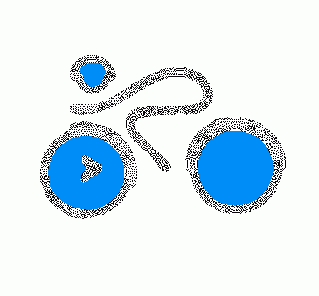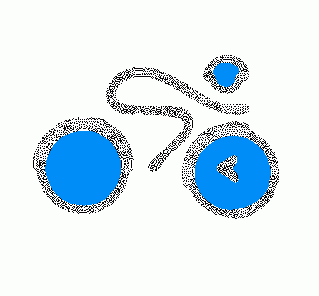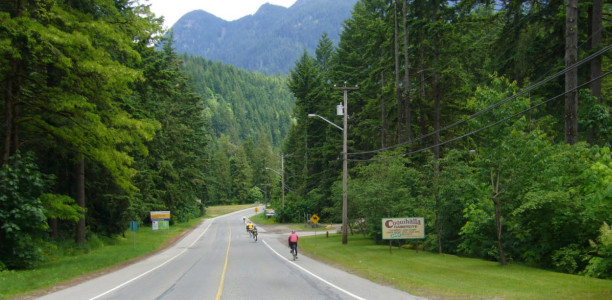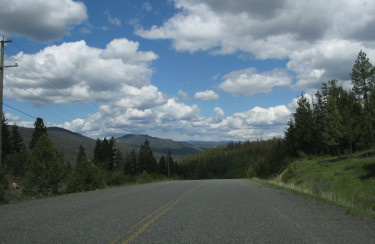| Newsletter - 2010 Archive |
 |
Cycling Club |
 |
| Newsletter - 2010 Archive |
 |
Cycling Club |
 |
Next>--->

Night and Day One of the interesting and completely illogical side effects of submitting a pin design (and having it accepted) is that you suddenly have a higher than normal motivation to do an entire series. If riding several hundred kilometers just to get a pin may be considered ridiculous, this obsession to collect the whole range of "your" pins must surely be proof that you have left the path of reason. Well, this is the position I have found myself in this year, thanks to Ali's work on my original, somewhat crude drawings. It was no trouble to find a 200 that worked. Laura and I did the Early Bird, had a great time on that, then attempted the Buccaneer 200. We were riding with our Fleche team, when we hit some ugly railroad tracks on 96th Avenue and Laura's season ended in a heap. I had to go back to Steveston anyway to retrieve the car, so once she and her bike were settled in Keith Fletcher's pickup, the rest of the team and I went on to the finish. The rescheduling of a minor operation kept me off the bike at a pretty inopportune time, so I decided to skip the very challenging Pemberton 300 (shucks) and take in the Interior 300. That turned out to be a great ride, where I found out how careful and thorough Bob Boonstra is when planning an event. My only complaint was against the bee that managed to land on my lip about 100 km into the ride. Luckily I closed my mouth in time. I can now testify that it takes an additional 130 km for the swelling to come up, and eventually subside again. During that time, you have a "drinking problem" dribbling a few drops of water down your chin with every swig from the CamelBak's hose. More scheduling issues forced me to push my 400 attempt to the summer series, but it looked like I could do the Spring Lower Mainland 600. Naturally, when I saw that Jeff Mudrakoff was going to run the Merritt Loop for that ride, I had serious misgivings: I have not done enough of a search through the archives to be sure of this, but the first time the Merritt Loop was used for the Lower Mainland 600, it generated more reports than I have ever seen for a non-ultra brevet. Mostly, they talked about just how tough things had been. Many complaints were registered against the weather, which had been rainy initially, fine on Saturday afternoon in the canyon, then cold and miserable on the Coquihalla. Some dark hints were even directed toward the route designer (me). Nobody said, "that was easy, let's do it again." On top of that, I had attempted the ride and had serious stomach problems. Highway 8, uphill, into a head wind, at the end of day one, was one long, blind misery, completely devoid of outhouses, where I was only dimly aware of the company of Manfred, Alard and Dug who saw my distress and stuck with me. I ended up bailing in Merritt. Hence, the extra nervousness. A suggestion that came up more than once was to run the route in reverse next time, stopping in Lytton (360 km) overnight instead of Merritt (345 km). This means most of the climbing is done at 200 km. Jeff managed to make it work with the help of extra volunteers. Jeff also organized a drop bag for Lytton, which relieved the pressure on the luggage situation. I rarely sleep much the night before a ride, so naturally, I started nervous, conservative and a little sleepy. I ended up at the back of a big pack of riders that stayed together all the way to Mission, the first control. The group broke up there as expected and I rode on trading pulls with Jerome and Guido all the way into Hope, the next control. We were compatible in size and strength, and made pretty good time into a light headwind, with cool temperatures and light cloud. After the control in Hope (where a number of cheeseburgers and whole battalions of fries gave their all), Guido took off, and Jerome and I agreed to regroup at the Coquihalla Summit control. I struggled to stay with Jerome on the steep rollers on Othello Road, but found my rhythm once we were on the steady climb of Highway 5 and pulled away in the increasing sun and warmth. This is the first time I have ever felt like I did on that climb. It was almost like another level of awareness, where I could tell exactly how much work I could do and not have stomach problems or waste my reserve. I simply stayed at that work level, and climbed better than I have ever climbed before. I sure hope I can do it again, because it is an amazing feeling. It would not surprise me to hear that other people have that sense more regularly, and I have been a little slow on the uptake. I think all endurance activities involve a strange balance of attentiveness and willful ignorance. On the one hand you pay attention, doing what your body needs to continue working, and on the other, you ignore your body's complaints so you can finish. I suspect that I have been better at ignoring than monitoring so far, but if this is any indication of how things could be, I need to pay more attention! Anyway, all good climbs must end, and if the high point of a 600 km ride is at the 200 km mark, you still have to complete the remaining 400 km. Jerome was feeling queasy when he arrived at the summit and suggested I go on without him. I rode pretty much alone into Merritt, surprised at how awful the road surface was until the Coldwater exit. In Merritt, I met a few other riders, and the Boonstra's were there offering some left over spaghetti. That really hit the spot. I went on from there alone with some trepidation about Highway 8. It turned out to be the best part of the ride. The Nicola Valley was beautiful, the river near bursting its banks. I did not have much power on the climbs, but there are not that many in that direction, so I got to Roger and Ali's secret control in Spences Bridge tired but early. The sun was down by then, so Nigel Aspinall and I combined our lights for the trip into Lytton. I must admit, by then I was feeling pretty run down. It was a quiet ride, but better for the company.  Coldwater Road I managed about three and a half hours sleep in Lytton, and left there alone, shortly after 0400, with food and spare clothing stuffed in every bag on the bike. I slowed enough at every restaurant in the Canyon to see that they were indeed closed, so I got a coffee and a plastic wrapped, plastic tasting, cinnamon bun in Boston Bar. Still not much power on the climbs, but feeling reasonably good. Dogwood Café was also closed when I got there, but Karen and Michel provided a timely hot chocolate. I suspect that location has outlived its usefulness as a control. The whole canyon strikes me as a long empty place, slowly losing services as traffic continues to shift to Highway 5. It's a shame, because it is a beautiful ride. The drizzle that had been sporadic until then, started to pick up when I finally stopped for a late sit down breakfast in Agassiz. It was almost constant on the ride from there into Mission, but when you have a tailwind, the last thing you wish for is a change in the weather. I got lost a bit where the route shifted us from the Lougheed to the Barnet. None of the locals I managed to flag down knew where the streets were, and I kept thinking they should be sooner. Eventually I found that gravel path, etc. and meandered my way onto Guildford. From there it was just the final grunt into increasing rain. Occasionally I would get closer to a rider ahead of me and then drift back when things got a bit steeper. I was starting to fade by the end and was almost hit by a truck when turning onto Boundary, but we both saw each other at the last second, thankfully. When I pulled into the Knight and Day, it turned out to be my best 600 ever by about 25 minutes. I was pretty stoked and willing to say that running the route "backward" was by far the better way. By my experience, the contrast was, well, like night and day. Statistically speaking, my elation does not seem to fit with the numbers from the two rides: In 2008, 6 riders DNF'd (if you count Kevin Bruce's, "oops, I forgot my rain boots") and the 23 finishers averaged 34:17. With this running, the DNF rate was lower at 5, but the 26 finishers averaged 34:58. Not that much different, really. Either way, thanks to Jeff for organizing the brevet, and for assembling a long list of volunteers to staff the long empty (s)miles. 
Go to: Results Go to: Photos June 9, 2010 |